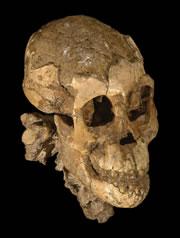 Little Salem is the most ancient toddler ever found.Zeresenay Alemseged and Copyright Authority for Research and Conservation of Cultrual Heritages (ARCCH)
Little Salem is the most ancient toddler ever found.Zeresenay Alemseged and Copyright Authority for Research and Conservation of Cultrual Heritages (ARCCH)The 3.3-million-year-old bones of a female toddler from Ethiopia are telling scientists a story about the route human ancestors took from the trees to the ground.
In today's issue of Nature, an Ethiopian-led international team reports the discovery of a juvenile skeleton of the species commonly known as 'Lucy', or Australopithecus afarensis.1,2 The researchers have named her Selam, after an Ethiopian word for 'peace'.
The specimen, which is the oldest and most complete juvenile of a human relative ever found, has features that stand as striking examples of part-way evolution between primitive apes and modern humans.
Although many other samples of A. afarensis have been found before, this is the first one reported to come complete with a whole shoulder-blade bone (scapula). In modern humans the scapula has a ridge running horizontally across the top of the bone; in apes the scapula's ridge reaches further down the back, where it can help to throw more muscle into arm action, as would be needed to swing from trees. In the young A. afarensis, the scapula looks to be part-way between.
"The animal was losing its capacity to be arboreal — heading right toward being human," says anthropologist Owen Lovejoy of Kent State University in Ohio.
 The ridge on little Lucy's shoulder blade (a) is intermediate between that of gorillas and chimps (b and d) and modern humans
The ridge on little Lucy's shoulder blade (a) is intermediate between that of gorillas and chimps (b and d) and modern humansOther hominins have been found before with traits that similarly show a cross between a life in the trees and one on the ground. A. afarensis, for example, has previously been found to have hips and knees thought to be adapted to standing upright, but curved fingers suited to grabbing branches.
But 'little Lucy' is a particularly striking example of this sort of mosaic of evolution, says Zeresenay Alemseged, lead researcher on the paper and a paleoanthropologist at the Max Planck Institute for Evolutionary Anthropology at Leipzig, Germany.
"These hominid fossils clearly show evolution in the making," he says.
Little star
ADVERTISEMENT
The fossils were unearthed at Dikika, just a few kilometres from the Hadar site in the Afar region of eastern Ethiopia — which in 1974 produced the original skeleton of Lucy, named after the Beetles song 'Lucy in the Sky with Diamonds', which was played during celebrations of the find's discovery.
When the first Dikika fossils were uncovered in 2000, Alemseged says it was unclear exactly what it was. But after comparison with specimens at the National Museum in Addis Ababa, he realized it was a young A. Afarensis.
Young bones are more fragile than their adult versions and seldom survive the rigors of time. This set survived in compressed sandstone sediments that probably washed over the young girl in a flood. It has taken five years to laboriously clean away from the bone using dental tools.
The specimen includes a skull (large enough for a chimp-sized brain), a near-complete set of teeth, and all of the major limb components.
Having such a complete set will provide researchers with a way to study developmental growth in this species.
Visit our lucyfossil_found.html">newsblog to read and post comments about this story.
